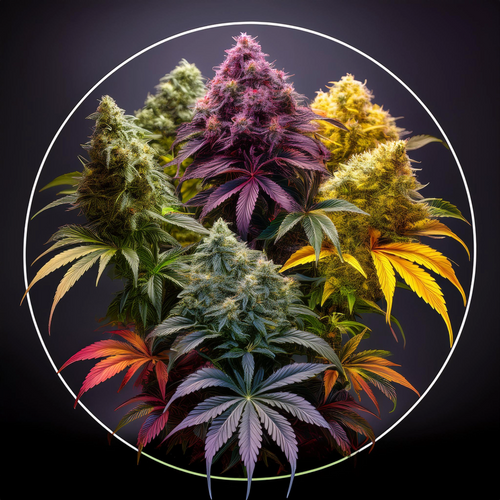
The art of crossbreeding cannabis plants has a long and fascinating history, from the early landrace strains to the modern, highly specialized hybrids that dominate the cannabis industry today. This process, which combines science and craft, has revolutionized the cannabis world and produced countless new strains with unique characteristics. In this blog post, we delve into the history of cannabis crossbreeding and explore how it has shaped today's cannabis culture.
Landraces: The Origins of Cannabis Genetics
Before crossbreeding cannabis plants became popular, there were so-called landrace strains . These are the original, unmodified varieties of cannabis that have adapted to the geographical and climatic conditions of their native region over thousands of years.
Well-known landrace varieties:
- Afghan Kush: From the mountainous regions of the Hindu Kush, known for its resin production.
- Thai: From Southeast Asia, known for its cerebral effects and long flowering times.
- Durban Poison: A sativa landrace from South Africa with energetic effects.
- Acapulco Gold: A legendary variety from Mexico with a golden appearance.
Landraces provided the genetic basis for modern cannabis breeding. Their robust characteristics and adaptability were crucial for the development of new varieties.
The Beginnings of Crossbreeding: The 1960s and 1970s
Crossbreeding of cannabis plants began in the 1960s and 1970s as cannabis became popular and the desire for new and unique strains grew. Breeders during this time often traveled around the world to collect landraces from different regions and combine their characteristics.
Why was there crossbreeding?
- Enhanced characteristics: Combining sativa and indica characteristics to combine the benefits of both species.
- Adaptation to growing environments: developing varieties that thrive in colder or hotter climates.
- Modifying effects and taste: Creating strains with specific flavors, effects and cannabinoid profiles.
The first hybrids:
One of the most famous early crosses was Skunk #1 , developed by breeders in California in the 1970s. It combined Afghan Indica, Colombian Sativa and Mexican Sativa to create a strain with fast growth, high yields and a powerful aroma.
The 1980s and 1990s: The Rise of Modern Breeding
In the 1980s, cannabis breeding reached new heights, especially in the Netherlands, where the legal environment allowed breeders like Sensi Seeds , Dutch Passion and others to professionalize their work. This era gave birth to many of the legendary strains that are still popular today.
Influential varieties:
- Northern Lights : A groundbreaking Indica known for its short flowering times and relaxing effects.
- Haze : A sativa with energetic, creative effects and a complex aroma.
- White Widow : A hybrid strain famous for its resin production and balanced effects.
During this time, feminized seeds and later autoflowering seeds were developed, making it easier for hobby and professional growers to access high-quality cannabis.
The Modern Era of Cannabis Breeding
Over the last two decades, cannabis breeding has evolved. Scientific advances, particularly in the field of genetics, have enabled breeders to develop strains with very specific characteristics.
New trends in breeding:
- High cannabinoid concentrations: strains with extremely high THC levels or a balanced ratio of THC and CBD.
- Terpene profile optimization: Breeders are placing increasing emphasis on aromas and flavors controlled by terpenes.
- Disease resistance: Development of varieties that are more resistant to pests and mold.
- Custom Effects: Strains specifically developed for specific medical or recreational needs.
Examples of modern varieties:
- Girl Scout Cookies (GSC): A mix of OG Kush and Durban Poison, known for its sweet taste and strong effect.
- Blue Dream: A hybrid strain appreciated for its relaxing yet energetic effects.
- Charlotte's Web: A high-CBD strain specifically bred for the treatment of epilepsy.
The Science Behind the Crossbreed
Today, breeding is no longer based only on traditional crossbreeding, but also on genetic analysis . Modern breeders use DNA testing to specifically select genes responsible for specific characteristics such as THC content, flowering time or disease resistance.
Molecular genetics makes it possible to breed varieties that are even more precisely tailored to the needs of consumers and farmers.
The Future of Cannabis Crossbreeding
The breeding of cannabis plants is only just beginning to reveal its possibilities. With increasing legalization and advances in biotechnology, even more exciting developments could follow in the future, such as:
- Personalized cannabis: strains developed based on the individual genetics and needs of the consumer.
- Industrialization of hemp: improved varieties for the textile, construction and food industries.
- Super-resistance: varieties that thrive even in extreme climates.
Conclusion
The history of crossbreeding cannabis plants shows how the plant has changed over the centuries to meet the needs of consumers and growers. From the original landraces to modern hybrids, cannabis has evolved into an incredibly diverse plant that continues to offer new possibilities. With the combination of traditional breeding and modern science, the future of cannabis breeding looks more exciting than ever!
